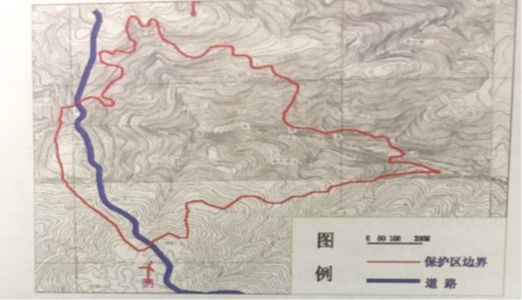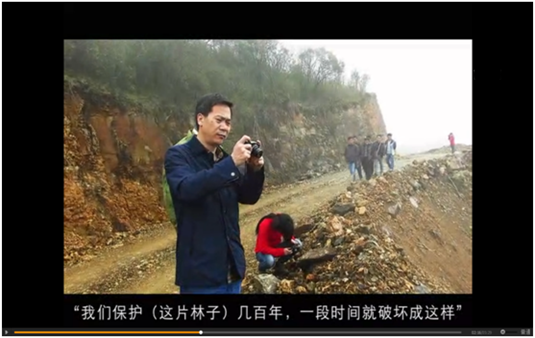DAMAGE OF LIRIODENDRON CHINENSE FOREST
- Case Study of Environmental Civil Public Interest Litigation
Case III
Section 1. Factual Background
A. About Liriodendron
Liriodendron chinense is a unique species in China and a second-class national protected plant, mainly growing in the south of the Yangtze River Basin. The leaf of Liriodendron chinense is like a mandarin jacket - the top side is flat, like the bottom of the mandarin jacket. Its flowers are big and beautiful. While Liriodendron chinense is frequently deforested, its main distribution area becomes rare.

Beautiful liriodendron chinense in autumn
B. About “Liriodendron Nature Reserve in Jianhe County”
Laozhai Village, Jianhe County, Qiandongnan Miao and Dong Autonomous Prefecture, Guizhou Province has the most massive known natural liriodendron forest in China. The Laozhai Village is also one of the first natural reserves registered in China through the ICCA registry of UNEP-WCMC. The reserve is a natural or improved ecosystem that contains important biodiversity values and ecosystem service functions indigenous and local communities' protection through customary laws or other effective means.
Since October 2013, the Liriodendron Nature Reserve started to attract more extensive attention. With the support of Guizhou Anthropology Society, Global Environment Facility Small Grants Program, Jianhe County government, and other units, the Laozhai Village has adopted more scientific and sustainable protection methods. In 2015, Guizhou Laozhai Liriodendron Community Reserve Management Committee won the sixth SEE ecological award for its management and protection of the Liriodendron Nature Reserve in Jianhe County.

SEE ecological award was given to Liriodendron Community Reserve Management Committee in Laozhai, Guizhou
The liriodendron chinense forest land in the Laozhai Village has significantly expanded from 50 hectares in the last century to more than 300 hectares (nearly 5000 mu). The management of liriodendron community conservation area tends to be more formal and professional. Cutting or stealing of trees has rarely occurred.
C. The Challenge of Laozhai Village
Since 2015, a unit started to build a wind farm project in the Old Mountain boundary of Jianhe County. The unit illegally occupied the forest land in the Liriodendron Nature Reserve to build roads on the mountain ridge, and the gravels produced when opening up the roads were arbitrarily discarded. Most of these stones rolled down the mountain ditch, crushed liriodendron trees in the middle of the mountain, and damaged the relevant ecological environment.
It is worth noting that the environmental impact assessment report of the wind farm project did not reveal that a road would be built to pass through the Liriodendron Nature Reserve. As a result, the villagers were not aware of the danger the construction would bring until the liriodendron forest had been seriously damaged. The villagers started to communicate with the construction unit, but the damages to the Reserve continued.

The geographical distribution of the protected areas and the roads built by the construction unit

(This picture and the following pictures are taken from “Hi Liriodendron!” by Friends of Nature)

Section 2. Pre-litigation Preparation
A. Whether Environmental Public Interest Litigation Is Feasible
After learning that environmental public interest litigation was likely to solve the problems ahead, Guizhou Laozhai Liriodendron Community Conservation Reserve Management Committee brought the case to the environmental civil public interest litigation advocacy and legal support network platform. The platform is composed of CLAPV and Friends of Nature.
This case involves the destruction of the second-class national protected plants and endangered species and happens within the nature reserve. As the practice field believes that the destruction of rare species/natural reserve constitutes the infringement of public social interests, we confirm the feasibility of a public interest lawsuit in this case.
B. Field Research
Our lawyers went to the case site in April 2016. We carried out the video recording, a simple calculation of damaged trees and areas, and satellite positioning of the involved site.

Then, we came to the Laozhai Village to meet with the villagers. After full communication, the villagers expressed their support to the subsequent environmental public interest litigation.

The volunteer lawyer of CLAPV discussed the case with the villagers
As the case involves the crime of illegal occupation of forest land stipulated in Article 342 and the crime of unlawful destruction of state key protected plants in Article 344 of the Criminal Law, we learned that the local public security department had investigated the case. The department confirmed that the construction unit dug down and destroyed liriodendron chinense trees, resulting in 13 deaths, nine crushed, 17 injured, and 185 buried by sand and earth, all of which were natural forests. Eighty-five of artificial trees were damaged as well.
Section 3. Prosecution and Trial
A. Announcement of Case Acceptance
After a period of investigation and evidence collection, CLAPV, as the supporting prosecution unit, and Friends of Nature, as the plaintiff, formally sued the construction unit on November 21, 2016, requesting the court of jurisdiction to make a ruling:
1. The defendant shall immediately stop the behavior that causes damage to the ecological environment of the Liriodendron Nature Reserve and its surrounding areas in Jianhe County and eliminate the danger to the ecological environment.
2. The defendant shall repair the Liriodendron Nature Reserve and its surrounding ecological environment within six months, and shall bear the repair cost if not fixed within the time limit.
3. The defendant shall compensate for the loss of ecological service function during the period from the damage of the ecological environment to the restoration of the original state, and the specific amount shall be subject to the appraisal and evaluation conclusion. The compensation shall be used for the management and protection of the Liriodendron Nature Reserve in Jianhe County.
4. The defendant shall bear the litigation cost of this case, including the case acceptance fee, appraisal and monitoring fee, expert fee, plaintiff's lawyer fee, etc.
The People's Intermediate Court of Qiannan Buyei and Miao Autonomous Prefecture of Guizhou Province formally accepted the case on January 3, 2017, and announced it according to law. During the period of acceptance announcement, Guiyang Public Environmental Education Center applied to participate in the lawsuit and was listed as a joint plaintiff.
B. Judicial Appraisal
We applied for appraisal to the court, asking to appraise the following matters: (1) the loss of ecological services from the date of the ecological damage to the recovery to the baseline level; and (2) the suggestions and costs for the ecological restoration of the damaged Liriodendron Nature Reserve in Jianhe County.
The court agreed and entrusted a third party to carry out the appraisal and evaluation, which results in the conclusion with two aspects:
1. According to the calculation method of restoration cost and equivalent analysis, the total cost of ecological restoration is 2,365,000 Yuan.
2. The area and diameter at breast height (DBH) of habitat are selected as the evaluation indexes of restoration, and it will take 14 years to recover to the baseline level. It is suggested to develop a follow-up investigation plan for the implementation effect of recovery. If the expected result cannot be achieved, supplementary restoration should be carried out in time
This conclusion reconfirmed the rationality of the plaintiff's claims. However, the calculation method adopted in the appraisal and evaluation report failed to draw the amount of "loss of ecological service function during the period from the damage of ecological environment to the restoration of the original state," which brought the plaintiff trouble in the subsequent mediation.
C. Assessment of Mediation
After the judicial appraisal and evaluation report was completed (in September 2018), the court conveyed the defendant's willingness to reconcile the case to us, and informed that: (1) the defendant, China Resources New Energy (Jianhe) Wind Energy Co., Ltd., had stopped the destruction of Liriodendron and its habitat, abandoned the construction of five wind power stands in the Reserve, and taken active measures to restore the Reserve while its re-greening design scheme had passed the review of forestry, environmental protection, and development and reform at the state and county levels; (2) the defendant had signed a supervision agreement on vegetation re-greening fund with the relevant competent departments; and (3) the 3 million Yuan of vegetation restoration deposit would be put into the account of Jianhe Investment Promotion Bureau for forest land vegetation restoration.
Given the expressed goodwill and active self-correction, we settled with the defendant on November 13, 2018, mainly including:
1. As for the determination of the damage results, all parties agree on the essential and compensatory restoration suggested in the environmental damage assessment report made by the Environmental Risk and Damage Assessment and Research Center of the Environmental Planning Institute of the Ministry of Environmental Protection. The restoration should be a total habitat area of 2.60 hm2, including 1.89 hm2 for essential recovery and 0.71 hm2 for compensatory restoration.
2. As for the repair measures, the defendant voluntarily performs the repair responsibility according to the quantities identified in the above appraisal and evaluation report. The defendant shall bear the engineering design cost and bidding-related cost, and shall report the repair progress to the plaintiff every year, and inform the plaintiff in writing of the acceptance report after the repair is completed.
3. The defendant shall submit the engineering design scheme to the people's court within three months after the effective date of this agreement. The program shall start within one year after the competent local department of liriodendron nature reserve approves it, and any violation of the above time limit is a refusal to perform the self-repair.
4. If the defendant fails to deliver the repairment as mentioned above, according to the scheme in the assessment report, it shall bear the court enforcement cost, including the project repair cost of RMB 2.365 million and the cost of re-bidding.
Section 4. Case follow-up
The conciliation statement came into force on 13 December 2018. The defendant submitted the engineering design plan to the people's court as scheduled. After the competent local department approved the program, the bidding announcement of the ecological restoration project was made on June 4, 2019. At present, the project is in progress and is expected to be completed by the end of 2019.
Under the joint efforts of the masses and environmental protection civil society organizations, the case was highly valued by Qiandongnan Prefecture People's Procuratorate, which organized relevant personnel and the State Forest Public Security Bureau to conduct field investigation at the scene of the crime. The construction unit was confirmed to illegally occupy 1,039.8 mu of forest land, deforest 5,220,896 cubic meters of trees, and arbitrarily destruct 282 second-class national protected plants.
At the same time, the state government investigated the impact of wind power projects on the ecological environment, formed a statewide research report, promoted the discussion of wind power projects, and passed a resolution to examine and approve the state wind power projects strictly. The relevant project leaders of the wind power company were investigated for the crime of illegally destroying the state's essential protected plants and the crime of deforestation.
Also, through the negotiation between local government departments and the defendant, the Laozhai Village was given 1.8 million Yuan to compensate for the loss of their collectively owned land caused by the illegal construction.
Section 5. Social Influence
The case was the top ten typical examples of the environmental resources trial of Guizhou court in 2019. The Guizhou Higher People's Court said, "The project involved in this case is a wind power generation project, which belongs to clean energy and is strongly advocated by the state. However, green projects also need green construction. The courts shall take a clear stand to crack down the wanton destruction of the ecological environment. The court, in this case, does not stop the project at one stroke. Instead, it guides the parties to seek the ecological restoration plan with minimum damages, properly handles the relationship between environmental protection and economic development, and achieves better legal, economic, and ecological environmental effects."
Section 6. Observation and Deliberation
Through the public interest litigation, the restoration of the nature reserve is urged to proceed in an orderly manner. Besides, the villagers' damages are compensated for. These achievements reflect the value of civil society organizations' participation in environmental protection. Before concluding the study of this case, we put forward the following reflection relating to the legislation:
Firstly, most of China's low-level nature reserves are loosely managed, lacking specific institutional and sustained financial supports. The reserve, in this case, has been set up as a county-level reserve for more than 30 years. For various reasons, there has no detailed management plan, no particular management unit and personnel, and no financial support. The villagers protect the precious species, spontaneously based on their affection for the ancestral land. Under such conditions, nature reserves are easily coveted by lawless people.
Article 31 of the Regulations on Nature Reserves provides, "The relevant administrative departments of the nature reserves shall set up special administrative organizations within the nature reserves and provide professional and technical personnel to be responsible for the specific management of the nature reserves." However, the operation of local level nature reserves, especially those below the county level, the good is mixed with the bad. At the same time, managers often lack awareness of the importance of nature reserves. Even though the number of China's nature reserves is at the forefront of the world, the protection provided by those reserves needs to be persistently improved.
The Regulations on Nature Reserves of 1994 are the fundamental guarantee for the management of nature reserves. However, with the rapid development of China, some provisions of the Regulations have lagged. The main problems include (1) the lack of scientific zoning;(2)unclear management classification system, property rights of natural resources, nature of management organization, and capital investment mechanism;(3)imperfect provisions of land use and land ownership;(4)large responsibility;(5) small power;(6) insufficient punishment; and(7)low illegal cost. We hope that the revision of the Regulations on Nature Reserves can be completed smoothly and that the local level will continue to issue relevant regulations to meet the specific needs of various areas, to enhance the management and supervision of nature reserves.
Secondly, China lacks the applicable technical specifications for the assessment of ecological environment damages to natural reserves and protected species, which makes full evaluation of the relevant ecological service functions difficult. Taking this case as an example, the restoration plan is expected to be completed by the end of 2019, and the habitat will take 14 years to recover to the baseline level. However, the loss of ecological service functions for this long period cannot be estimated. As a result, the compensation for the loss of ecological service functions is not concluded in the conciliation agreement of this case. The cause of the problem is not only the lack of legal guidance but also the lack of technical feasibility, which will take time to overcome.

P.S. This report is supported by the Heinrich-Böll-Stiftung (Germany) Beijing Representative Office, but the content of the report does not represent the position of the sponsor.